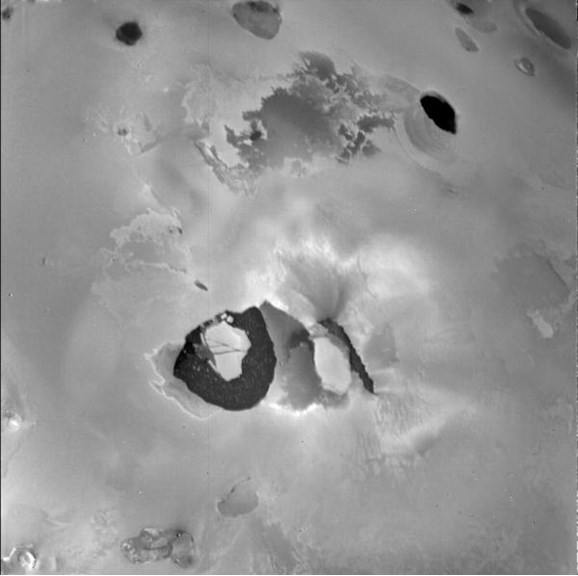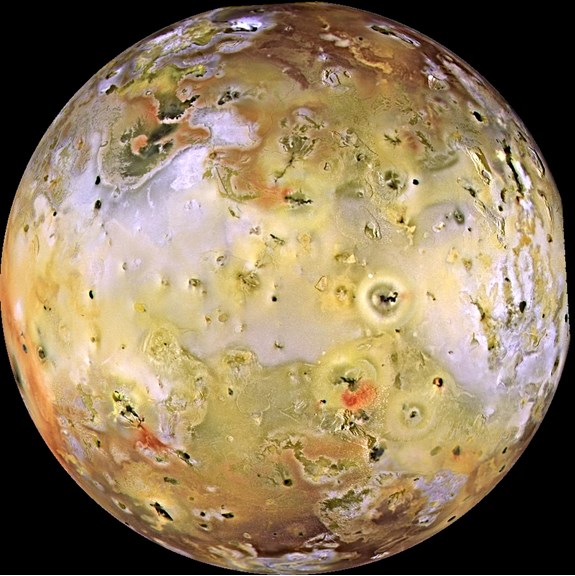Skynotes: November 2019
Io’s Loki Volcano Erupts on Schedule
Volcanic activity on Jupiter’s moon Io is widespread with Loki the largest and most powerful volcano. Over 20 years of Earth-based telescope observations, Loki has erupted more or less every 540 days during the 1990s, but more recently it seems to be every 475 days. Its behaviour is especially obvious in infrared. This cycle of eruption is not absolute although being such a large volcano seems to explain much of its behaviour. However, many factors come into play – available magma and its condition, the state of underlying rock, and the gravitational flexing and heating the moon undergoes in its 42 hour orbit of the giant planet.
Loki volcano has a lava lake named Loki Patera, but the entire surface of the moon is covered in volcanic calderas, lava lakes, with silicates and sulphur compounds dominating under a very thin atmosphere of sulphur dioxide.
Io is the most volcanic object in the solar system. From the early Voyager missions, the later Galileo probe, and most recently Juno currently in orbit around Jupiter, and from Earth-based observations, has come a growth in understanding of this dynamic moon, not to mention spectacular images capturing its constantly changing surface.
Month highlights
This month a chance to see four solar system bodies in the same part of the sky occurs when a crescent moon, Venus, Saturn, and Jupiter all appear in the west on the evening of 29th.
Planetarium events
Planetarium Nights | Friday 1, 8, 15, 22 & 29 November
Evenings for adults
7.30pm – Ticket to the Universe
9.00pm – Biosphere + INITI
Journey to Pluto | Monday 4 November, 6.30–9.00pm
Nearly 15 years ago a small spacecraft left Earth bound for one of the most distant objects in the solar system. Reaching its destination, we were treated to exquisite views of Pluto and its large moon Charon. Join us for a mission report, and a very rare opportunity to hear from NASA New Horizons Missions Operations Manager Alice Bowman in conversation with Emmy award-winning journalist and author Sara James.
Party Beyond x Due West | Saturday 16 November, 7pm–11pm
For one night only Scienceworks and the Planetarium becomes the coolest night club in the west with musicians and DJs performing in all our galleries. For this epic after-hours party, space enthusiast and musician BATTS will present a gorgeous experience under the dome with her album inspired by the Voyager mission. Planetarium tickets are included with event entry, but make sure you book as seats are limited!
Melbourne sun times
| Date | Rise / Solar noon§ / Set (day length) |
|---|---|
| Fri 1st | 6.14am / 1.03pm / 7.54pm (13.40 hrs) |
| Mon 11th | 6.03am / 1.04pm / 8.04pm (14.01 hrs) |
| Thu 21st | 5.56am / 1.05pm / 8.15pm (14.19 hrs) |
| Sat 31st | 5.52am / 1.08pm / 8.25pm (14.32 hrs) |
§ When the Sun is at its highest crossing the meridian or local longitude.
Moon phases
| Phase | Date |
|---|---|
| First Quarter | Monday 4th |
| Full Moon | Wednesday 13th |
| Third Quarter | Wednesday 20th |
| New Moon | Wednesday 27th |
The Moon will be at apogee (furthest from Earth) on Thu 7th at 405,058 km and perigee (closest to Earth) on Sat 23rd at 366,716 km.
Planets
Mercury is very low in the west in the evening in early November but then become lost in twilight as it moves closer to the Sun.
Venus is low in the west in the evening and moves steadily higher through Libra, Scorpius, and then Sagittarius.
Mars should be visible from mid-month very low in the east before sunrise.
Jupiter remains bright and clear in the west during the evening to the right of Scorpius and will then cross into Sagittarius.
Saturn remains visible in Sagittarius, the Archer. Look to the right of the handle of the upside down ‘Teapot’ (which forms part of the archer’s bow and arrow).
Meteors
The Taurids is an old meteor stream peaking in the first week of November. They can be bright, slow moving, with occasional colourful fireballs. One branch appears near the star cluster Pleiades and the other near the red star Aldebaran in Taurus which rises in the north-east around 10pm. Around 10 per hour can be seen, but every few years activity increases with brighter meteors and more fireballs.
The Leonids occur from 13th - 20th peaking on the morning of the 18th. They result from Comet Tempel-Tuttle that orbits every 33 years. It reached perihelion (closest to Sun) in 1998 after which thousands were seen globally per hour. Since then the rate has been about 15 per hour. They appear in the direction of Leo, the lion, which rises in the north-east around 4am, are fast and leave lots of trains that can last several minutes.
Stars & Constellations
Scorpius and Sagittarius are in the south-west after sunset. Much later in the night the Pleiades star cluster, Taurus, the bull and Orion, the hunter will rise one by one in the east.
The Southern Cross is now upside down during the early evening with The Two Pointers to the right and the bright star Canopus to the left.
More easily seen this month is the most distant object visible to the naked eye, the Andromeda Galaxy (M31 in Charles Messier’s catalogue). It appears as a faint smudge just above the northern horizon, sitting below and to the right of the square of Pegasus, the winged horse.
On this day
1st 1963, then largest radio telescope, the Puerto Rico Arecibo Observatory, opens utilising a natural valley and transceiver suspended from pylons on nearby peaks.
3rd 1957, Laika, a 3-year husky-Samoyd dog, became the first animal into orbit in Sputnik 2 (USSR). While never intended to return to Earth, she expired from heat stress after only a few hours.
3rd 1973, Mariner 10 (USA) launches to Mercury, the first probe to use a gravitational ‘slingshot’ around a planet to reach an objective (in this case, Venus).
4th 2003, largest solar flare recorded causes radio blackouts and saturates satellites, and was associated with a Coronal Mass Ejection (CME) many times larger than Earth leaving the Sun at 2,300 kph.
8th 1656, birth of second Astronomer Royal Edmund Halley who calculated several historical comets to be the same. He successfully predicted its regular 76-year return. It posthumously carries his name.
9th 1934, birth of American astrophysicist and science communicator Carl Sagan.
12th 2014, First landing on a comet and direct surface images of Comet Churyumov-Gerasimenko by Philae lander from ESA’s Rosetta probe.
12th 1980, Voyager 1 (USA) has historic close encounter with Saturn at 124,000km. It then flew by moon Titan which precluded going on to Uranus or Neptune, both however visited by its twin Voyager 2.
13th 1971, Mariner 9 (USA) is the first spacecraft to orbit another planet, Mars. Months of a planet-wide dust storm finally cleared to allow pictures of the surface.
15th 1738, discoverer of Uranus and infrared radiation, William Herschel, is born.
14th 2003, Sedna, a TNO (Trans Neptunian Object) is discovered in a 11,400 year elongated orbit, one of the most distant objects known in the Solar System.
16th 1965, Venera 3 (USSR) is launched to Venus becoming the first probe to reach the surface of another world.
16th 1974, first radio message sent into space (USA/Puerto Rico). ‘Arecibo Message’ to star cluster M13 25,000 light years away took 3 min. Its 1,679 binary 1’s and 0’s if arranged in 23 columns and 73 rows will reveal visual information (prime numbers 23 x 73 = 1,679).
17th 1970, Lunokhod 1 (‘Moon Walker’, USSR) first remote-controlled moon rover. Delivered by lander Luna 17, it drove 10km and lasted 321 Earth days, far longer than the expected 3 months.
20th 1998, First module for the ISS, Russia’s 12 metre Zaryu (‘Sunrise’) or Functional Cargo Block, is launched beginning a multi-module multi-year assembly of the space station in low Earth orbit.
26th 2012, Curiosity rover (USA) arrives in Mars’ Gale Crater after a high-speed entry and first use of an innovative final landing technique – the ‘sky crane’.
27th 1971, first probe to reach the Martian surface is Mars 2 (USSR) although it crashes in the process.
27th 2001, first detection of composition of exoplanet’s atmosphere – by Hubble Telescope for planet Osiris orbiting a sun-like star 150 light years away.
28th 1967, Cambridge postgraduate student Susan Jocelyn Bell discovers the first pulsar, initially named LGM1 for “little green men”. Its regular 1.3 sec radio pulse revealed these pulsating stars to be rapidly spinning neutron stars.
29th 1967, Australia becomes the third nation after USSR, USA and France to launch a satellite from its own territory. The 45kg WRESAT-1 (Weapons Research Establishment Satellite) made 642 polar orbits until re-entry 11 days later.
30th 1609, Galileo studies the Moon with his improved telescope, and while not the first to do so he was the first to explain mountains and craters, and chart lunar features and their heights.
30th 1954, Ann Elizabeth Hodges of Alabama, USA, becomes the first person injured by a meteorite. She was badly bruised by a 5kg rock that crashed through her roof, deflected off a radio cabinet, and hit her while she was asleep on the couch.

